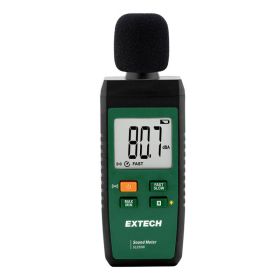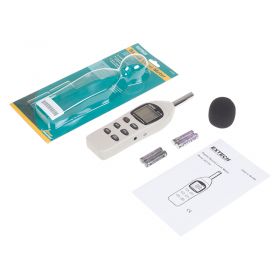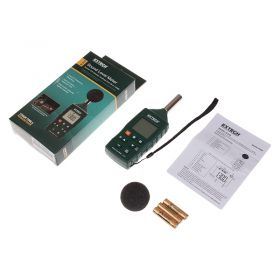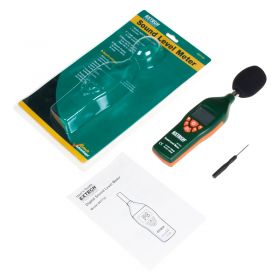Sound Meters
-

 Extech SL250W Sound Meter with ExView App Connectivity£92.40 £77.00
Extech SL250W Sound Meter with ExView App Connectivity£92.40 £77.00- 30 to 130dB with ‘A’ weighted frequency for human hearing
- Data Hold, Min/Max Recording, & Auto Power Off
- Compatible with Extech’s free ExView App
77 Reward PointsPrice Match GuaranteeSL250W -

 Extech 407730 Digital Sound Level Meter£102.00 £85.00
Extech 407730 Digital Sound Level Meter£102.00 £85.00- Analogue bargraph and 2000-count LCD display
- Lightweight, auto-off and slow/fast response time
- Records min/max values using electret condenser microphone
85 Reward PointsPrice Match Guarantee407730 -
 Extech SL510 Sound Meter
Extech SL510 Sound Meter £130.80 £109.00
£130.80 £109.00- ‘A’ &‘C’ Frequency Weighting
- Backlit display
- ±1dB high accuracy
109 Reward PointsPrice Match GuaranteeSL510 -

 Extech 407732 Type 2 Low/High Range Sound Level Meter£137.06 £114.22
Extech 407732 Type 2 Low/High Range Sound Level Meter£137.06 £114.22- High accuracy meets ANSI and IEC 651 Type 2 standards
- High and Low measuring ranges: 35 to 100dB (low) and 65 to 130dB (high)
- Data Hold and Max Hold functions
114 Reward PointsPrice Match Guarantee407732
About Sound Meters
Used mainly for measuring sound in industrial and environmental areas and for quantifying sound levels on aircraft, a sound level meter is an essential tool for professionals working in areas where measuring sound accurately is a high priority.
A sound level meter from Tester will allow you to measure various amounts of sound within your workspace, ensuring that it is at a safe operating level for human ears. In noisy environments, not protecting employees' ears can lead to noise-induced deafness, so it is important to evaluate the sound levels within your workspace if you're working with loud machinery, devices, or vehicles.
When measuring the levels of noise in an area, regulations state that the level of LEP,d (worker's daily exposure to noise) must conform to certain standards as dictated by the Physical Agents Noise Directive; an EU directive that came into effect in April 2006. These are:
- Lower action level (LEP,d 80dB(A)) - Individual hearing protectors should be made available, and training and information on the risk of hearing damage must be given to workers.
- Upper action level (LEP,d 85dB(A)) - Noise must be reduced where it can be. All employees must have hearing protectors and make sure they wear them. Again, training and information must be provided on correctly using hearing protectors.
- Exposure limit (LEP,d 87dB(A)) - Under no circumstances should the exposure of the worker exceed these limits as it can be extremely dangerous.
By using a sound meter you can accurately measure the daily exposure a worker may be exposed to and then take relevant steps to ensure their hearing doesn't suffer lasting damage.
Sound Meter Types (Classes)
Sound level meters are not placed into one collective group - depending upon applicable standards they are defined as what's known as sound meter classes, or sound meter types. The most generally accepted definition of a sound meter comes from IEC regulations, which define that sound meters are placed in two different classes.
Known as class 1 and class 2 sound meters, this standard defines the difference between the two in the meters' overall tolerance for error. Class 1 meters generally ship with a wider frequency range and tighter tolerance, whereas class 2 meters are defined by the fact that they have a lower frequency wider, and lesser tolerance. This means that Class 1 sound level meters are much more accurate and therefore are much more acceptable for use in noise surveys, particularly where measurement accuracy is of the utmost importance.
In addition to classes, the ruling IEC 61672-1 inserts sound meters into "three kinds of sound measuring instruments". These are defined as a conventional sound level meter, an integrated-averaging sound level meter, and an integrating sound level meter.
Certain types of sound meters - which are governed by IEC 61252: 1993 - are known as noise dosimeters (noise dosemeters in Britain). These meters are designed to integrate directly with a person to determine the noise exposure of that person over time and are commonly used to comply with regulations such as Occupational Safety and Health (OSHA) 29 CFR 1910.95 Occupational Noise Exposure Standard or EU Directive 2003/10/EC.
Accepted Sound Meter Standards
To be classified as acceptable for use a sound meter generally must adhere to the standard IEC 61672 (or British standard equivalent BS EN 61672) to gain certifiable status as a Class 1 or Class 2 sound level meter. Depending on the type of meter being used this standard may or may not be applicable in conjunction with other standards, and there are several other standards available for things such as noise dosimeters, personal sound exposure meters, and various other devices. Sound calibrators are also governed by their standards.
The following is a list of the currently accepted sound meter standards available around the world:
IEC 61672 - Electroacoustics - Sound Level Meters
The most commonly used standard, IEC 61672 is used as a quantifying tool for defining whether a modern sound meter is given class 1 or class 2 status. The status is given depending on the tolerance and overall frequency range of the sound meter; class 1 meters have a much higher tolerance than class 2 do, making them a much more accurate tool for quantifying overall sound levels.


